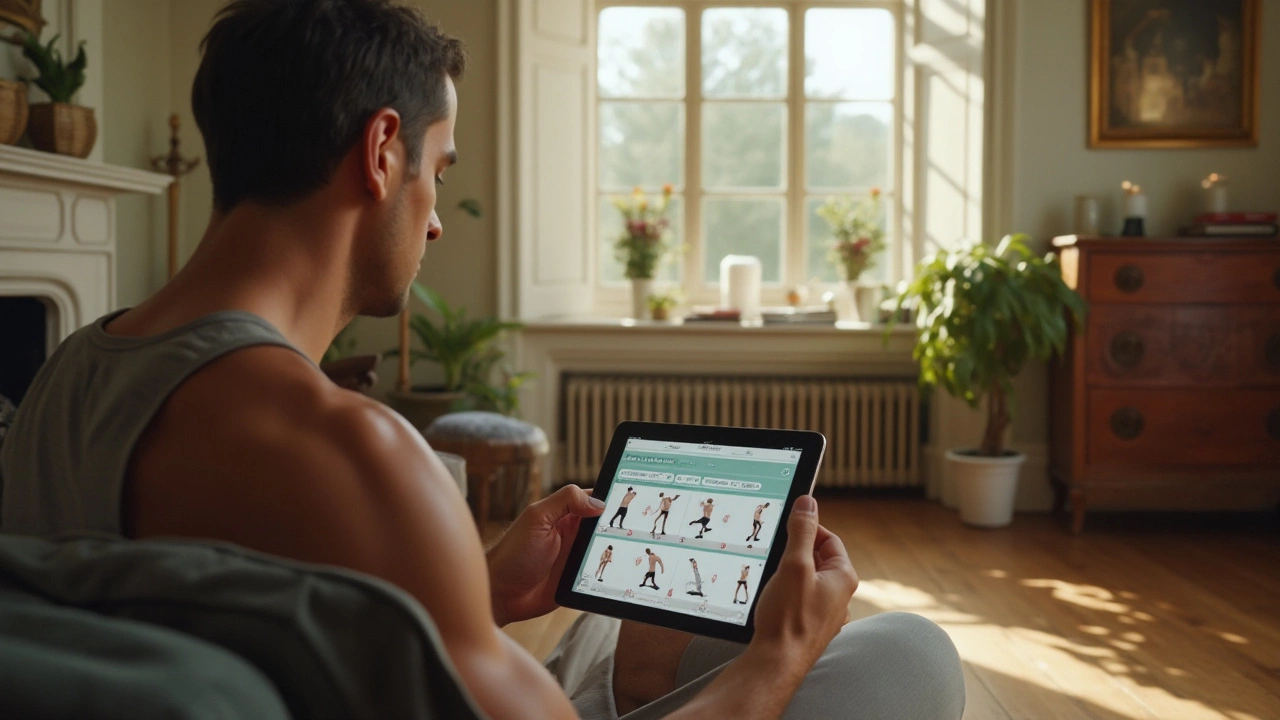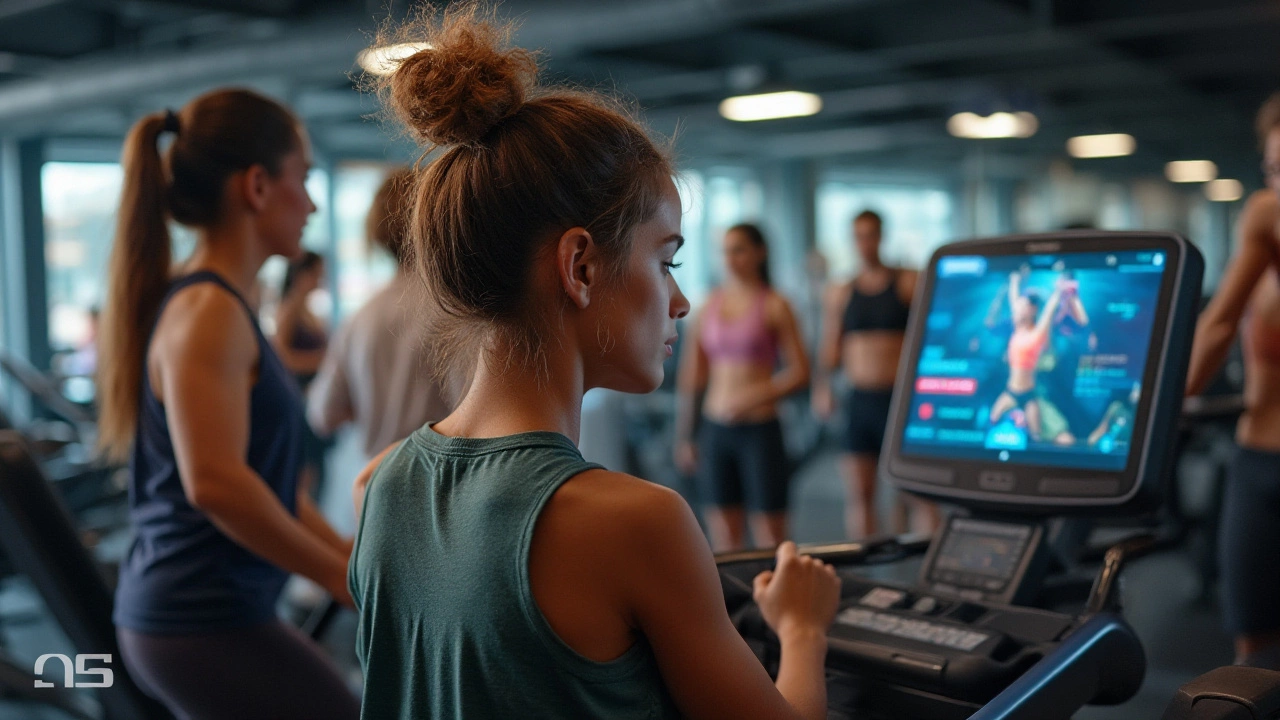
Exercise apps have become an essential part of many people's fitness routines, offering the convenience of a virtual personal trainer right on your phone. As more folks look to stay healthy without the hefty price tag of gym memberships, free exercise apps stand out as a practical solution. Each app provides a blend of features designed to guide users through workouts tailored to their needs.
Whether you're just starting out on your fitness journey or searching for ways to spice up your usual routine, diving into the world of exercise apps can be both exciting and overwhelming. With an abundance of options, it’s important to identify what aligns with your goals. Let's explore some standout free exercise apps and help you make an informed decision.
In today's digital age, finding a personal trainer or signing up for a gym class is only a few taps away, thanks to the plethora of exercise apps available. These little powerhouses of fitness have revolutionized how we look at maintaining and achieving our health goals. What was once limited to static, printed workout routines has now transformed into dynamic, ever-evolving platforms that cater to people's individual preferences and lifestyle needs. Leveraging the vast potential of free fitness apps, users can access workouts that are customized to their specific goals, fitness level, and even the amount of time they have available.
The market for these apps is quite expansive, with hundreds of applications offering varied features from simple calorie counters and steps trackers to hyper-specific training regimens. They empower users to experience the benefits of professional workout guidance without the costs typically associated with gym memberships or personal trainers. At the core, the concept is simple: provide accessible, on-the-go workouts that bypass the restrictive schedules or high fees of traditional fitness options. According to a recent survey, the global fitness app market exceeded $5 billion in value, demonstrating the popularity and reliance on these digital fitness assistants. This surge is driven not only by the ease and accessibility but also by the innovations in wearable technology that seamlessly integrate with these apps, offering a holistic view of one's fitness journey.
As fitness apps continue to gain traction, the offerings have become increasingly sophisticated. Many apps now offer personalized workout plans, short instructional videos, and even motivational coaching tips, which feel like a virtual trainer in your pocket. Diving deeper into their features, many apps leverage AI and machine learning to analyze a user's performance data, providing insights and adjustments to optimize results. Such features, once unimaginable, have elevated exercise apps from mere novelties to essential tools in a balanced lifestyle approach. As one health expert noted, "The real beauty of fitness apps lies in their ability to democratize personal fitness. They're breaking down barriers, making it conceivable for anyone, regardless of their financial or geographical constraints, to maintain a healthy lifestyle".
Fitness apps tackle both conventional and unconventional exercise routines, ranging from yoga and Pilates to high-intensity interval training (HIIT) and strength conditioning. This level of diversity caters to a broad spectrum of fitness enthusiasm. For instance, if you're new to exercise, many apps have beginner-friendly plans that ease you into the fitness world, whereas advanced users can find challenging programs that push their limits. Ultimately, these tools are there to serve you in whichever form you need them, adapting as you grow stronger and more confident in your capabilities. With so many exercise apps sprouting up, users are spoiled for choice but need a thoughtful approach to select the app that truly aligns with their physical aspirations and daily schedules.
In summary, the landscape of health and fitness is rapidly evolving, and free workout apps have firmly established their place as vital components. Whether you're setting new goals or maintaining existing regimens, these apps are more than just virtual tools—they're partners in your quest for a healthier, happier life.

In an era where technology seamlessly integrates with our daily lives, exercise apps have democratized fitness in remarkable ways. These digital tools offer guidance, track progress, and inspire users to reach new health milestones. Among the array of options available, several standout contenders have distinguished themselves through user-friendly interfaces, versatile workout plans, and engaging features. Whether you're a yoga enthusiast or someone wanting to embark on a weightlifting journey, there’s an app tailored just for you.
One popular choice among fitness enthusiasts is MyFitnessPal. Renowned for its comprehensive database and user-friendly design, it not only tracks your workouts but also provides intricate details on nutrition, aiding users in understanding their caloric intake relative to their activity levels. This holistic approach to fitness makes it a favorite for many. According to Business Insider, "MyFitnessPal consistently ranks high due to its all-in-one features, blending exercise tracking with nutritional guidance." Indeed, the app's strength lies in its ability to weave together the diverse facets of a healthy lifestyle, making it a powerful ally for anyone on a fitness journey.
Strava, uniquely designed for runners and cyclists, leverages community spirit by connecting individuals with groups based on location and preferences. This social aspect turns those solitary jogs into opportunities for competition or camaraderie. By breaking down workouts into segments, users can track improvements over time, lending a sense of achievement and motivation. With millions of users globally, Strava has become synonymous with loyal and driven fitness communities. Additionally, they offer a unique feature, where users can create their paths and share them with others, fostering a culture of exploration and adventure in fitness.
Those who thrive on variety and unpredictability may gravitate toward Nike Training Club. This app boasts a vast library of workouts, from high-intensity interval training (HIIT) to calming yoga sessions—an ideal mix for those who love experimenting with different exercise styles. Nike Training Club frequently updates its library with new workouts, keeping your routine fresh and challenging. A handy feature here is the personalized recommendation system, which curates workouts based on your past choices and performance, ensuring you're continually challenged and never bored.
For yoga lovers, Daily Yoga offers comprehensive asanas and breathing exercises that cater to all levels, from beginners to seasoned practitioners. This app provides detailed guidance throughout your practice, ensuring your alignment and postures are on point. As yoga transcends mere physical exercise to become a journey toward mental clarity and focus, these elements make it indispensable for anyone aiming for holistic well-being. As one fitness expert said,
“Daily Yoga is not just an app; it's an inspiration that helps carry the serenity of the mat into everyday life."This endorsement highlights the authentic connection users often develop with their chosen app.
As we explore these options, it's crucial to recognize that the best exercise app truly depends on individual goals and preferences. Whether you're seeking camaraderie, specificity, or variety, the app markets offer a spectrum of choices that cater to diverse needs. Embrace the opportunity to try multiple apps and identify the one that resonates with your lifestyle, ensuring your fitness journey remains an enjoyable and sustainable part of your life.

When diving into the realm of exercise apps, it's essential to pinpoint features that enhance your fitness journey rather than hinder it. A standout app should have a user-friendly interface, which means it’s intuitive and easy to navigate. You don’t want to spend crucial workout time fiddling with confusing menus or settings. Many users appreciate customization options, allowing them to tailor workouts to their specific needs. Such personalization can make the difference between sticking with a routine and abandoning it altogether. Sometimes it’s the little things, like adjusting the type of music that plays during a session, that make an app enjoyable and motivating.
Another crucial feature is the range and quality of workout programs available. A top-tier app should offer a diverse set of exercises, catering to beginners up to advanced athletes. From yoga, strength training, to cardio workouts, variety is key. Integrated video demonstrations can guide users effectively, ensuring proper form and reducing the risk of injury.
One of the main advantages of fitness apps is their ability to track progress. Features that allow for tracking not only keep users motivated but also enable them to monitor improvements over time. Look out for apps that offer insights into calories burned, steps taken, or even compatibility with devices like heart rate monitors. Such data can be visually represented through graphs or charts for better understanding and encouragement.
According to a recent survey conducted by the Journal of Medical Internet Research, over 65% of users reported feeling more accountable for their fitness routines thanks to app progress tracking features.
In addition to tracking, motivational incentives such as achievements or reminders can act as a digital pat on the back. These features create a game-like experience where earning a new badge becomes just as rewarding as reaching the next level in a video game.
The best free workout app often fosters a sense of community. Whether through forums, group challenges, or leaderboards, interacting with other fitness enthusiasts can be empowering. Some users relish the idea of participating in virtual runs or workout challenges, which adds a competitive edge while still promoting camaraderie. A community feature can replicate the atmosphere of a physical gym environment, making exercising more engaging than solitary routines.
When browsing for the perfect fitness app, ensure these essential features align with your goals and lifestyle. The right app can be a step toward achieving fitness milestones and embracing a healthier you.

Using exercise apps is a brilliant way to incorporate fitness into your daily routine, but making the most out of these tools requires a bit of strategy and insight. First and foremost, it’s essential to set clear and achievable fitness goals. Whether it’s shedding a few kilos, building muscle, or maintaining a consistent fitness regimen, knowing exactly what you want serves as a compass to guide your app-related decisions. By honing in on your objectives, you can select workouts within the exercise app that cater specifically to your needs, making every session more effective and efficient. Along with this, tracking progress on a regular basis helps in maintaining motivation. Most fitness apps come with features to log workouts and monitor improvements, and these self-assessments can be incredibly revealing. Remember that fitness is a journey, and recognizing even small victories along the way can keep you inspired.
One practical tip is to schedule your workouts just like you would any other important appointment. This not only builds a habit but elevates the priority of exercise in your life. Using the reminder features often found in fitness apps can serve as a helpful nudge to get moving. Equally crucial is having a dedicated workout space, even if it’s just a corner in your living room. A clutter-free environment makes it easier to focus and commit to the routine. Consistency is key, and by chaining habits into your daily life, the likelihood of sticking with your fitness plan increases significantly. According to a study from Dr. Benjamin Gardner at King’s College London, creating small, deliberate routines can evolve into automatic behaviors over time. Therefore, it’s beneficial to align your workout times with existing habits for reinforcement.
Incorporating variety into your routine ensures that exercise remains stimulating and doesn't turn mundane. Many free workout apps offer a wide range of exercises, from yoga and pilates to high-intensity interval training and strength sessions. Mixing up your workouts not only keeps things fresh but also challenges your body in various ways, promoting balanced fitness. Staying open to trying new routines can lead to discovering new passions or preferences within fitness. It's also helpful to occasionally explore app updates or new feature releases, as developers often introduce innovative exercises or techniques. Engage with community features if the app provides them, as sharing experiences and gaining support from others can enrich your fitness journey. Plus, interacting with other users introduces a social element to workouts, amplifying motivation through camaraderie.
A final takeaway is to remain patient and be kind to yourself throughout the process. It's easy to fall into the trap of comparing your progress with others, particularly when visible results can vary significantly from person to person. Engage with exercise apps primarily for personal growth and wellness, remembering that fitness is as much about mental well-being as it is about physical health.
“Fitness is not about being better than someone else. It’s about being better than you used to be,” bodybuilder Khloe Thompson once said, and it resonates profoundly with anyone pursuing improvement through fitness apps. Keeping this perspective aids in enjoying the process more and less about achieving a certain aesthetic.
To wrap up, integrating exercise apps into your life can be rewarding and impactful with the right approach. Pinpoint specific goals, maintain a schedule, embrace variety, and appreciate both big and small advances. By weaving these practices into how you engage with the best exercise app for your needs, you'll be setting the stage for a truly empowering fitness journey.